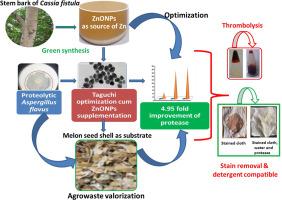Optimization of production of detergent-compatible and thrombolytic protease by Aspergillus flavus AT grown on agrowastes using Taguchi technique cum nanoparticles supplementation
引用次数: 0
Abstract
Microbial proteases are important industrial enzymes with diverse applications. However, their production is expensive due to the cost of media, thereby necessitating the search for cheap substrates for their production. In this study, novel optimization regimen was applied to increase protease production by a local strain of Aspergillus flavus by deploying the Taguchi technique with the incorporation of ZnONPs. The isolate produced protease in both SmF and SSF by utilizing groundnut peel (GP), groundnut shell (GS) and melon seed shell (MS) with titers in the range of 24.20–45.65 U/ml for SmF and 18.15–152.90 U/g for SSF, respectively. Its protease production was further optimized in the underutilized MS, which has not been reported for protease production until now. Taguchi cum nanosupplemention in SmF increased protease production from 37.40–185.25 U/ml as the global optimum with the inclusion of ZnONPs accounting for up to 10.74 % of the production. The improved production of protease was 4.95 fold compared with the unoptimized bioprocess. The protease was effective for blood stain removing and showed enhanced proteolytic activities of 254.72–329.10 U/ml corresponding to performance of 137.50–177.65 % in the presence of four detergents indicating high level of compatibility. The protease also dissolved blood clot by 91.30 %, thereby making it useful as thrombolytic agent. For the first time, we report the microbial production of protease using MS-based media and enhanced its production via incorporation of nanoparticles. Thus, the detergent-compatible protease produced in this study has industrial and biomedical applications.

利用田口技术和纳米颗粒的补充优化黄曲霉在agrowastes上生长产生与洗涤剂相容的溶栓蛋白酶
微生物蛋白酶是具有多种用途的重要工业酶。然而,由于介质的成本,它们的生产是昂贵的,因此有必要寻找廉价的基材来生产它们。在这项研究中,采用了新的优化方案,通过引入ZnONPs的田口技术,提高了黄曲霉本地菌株的蛋白酶产量。该菌株对花生皮(GP)、花生壳(GS)和瓜子壳(MS)均能产生SmF和SSF的蛋白酶,SmF的效价分别为24.20 ~ 45.65 U/ml和18.15 ~ 152.90 U/g。在未充分利用的MS中进一步优化了其蛋白酶生产,目前尚未有蛋白酶生产的报道。在SmF中添加Taguchi和nanoadd使蛋白酶产量从37.40-185.25 U/ml增加到全球最优,其中ZnONPs的产量高达10.74%。与未优化的生物工艺相比,改进后的蛋白酶产量提高了4.95倍。该蛋白酶具有较好的去血渍效果,在4种洗涤剂的作用下,其蛋白水解活性为254.72 ~ 329.10 U/ml,对应于137.50 ~ 177.65%的性能,显示出较高的相容性。该蛋白酶还能溶解91.30%的血凝块,从而使其成为有效的溶栓剂。我们首次报道了微生物利用质谱培养基生产蛋白酶,并通过加入纳米颗粒提高了蛋白酶的产量。因此,本研究生产的与洗涤剂相容的蛋白酶具有工业和生物医学应用价值。
本文章由计算机程序翻译,如有差异,请以英文原文为准。
求助全文
约1分钟内获得全文
求助全文

 求助内容:
求助内容: 应助结果提醒方式:
应助结果提醒方式:


